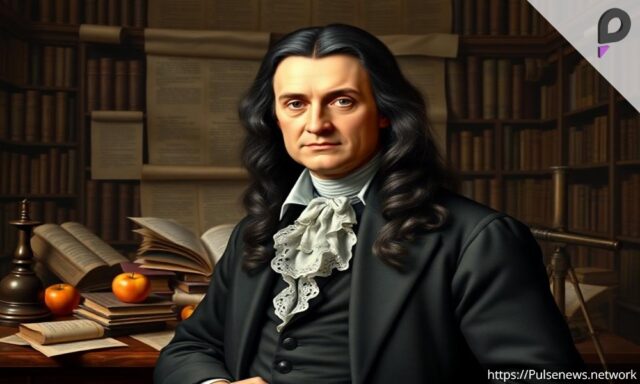Sir Isaac Newton is regarded as one of the most pivotal figures in the history of science. His groundbreaking contributions to mathematics, physics, and astronomy not only transformed our understanding of the natural world but also laid the bedrock for much of modern science, shaping countless fields of study. Newton’s discoveries have had a profound impact on the world, shaping everything from the laws of motion to the understanding of gravity.
Early Life of Sir Isaac Newton
Isaac Newton was born on January 4, 1643, in Woolsthorpe, a small village in Lincolnshire, England, marking the beginning of a life that would profoundly change the course of science. Premature at birth, he was initially not expected to survive, defying the odds from the very beginning. His father, also named Isaac Newton, passed away three months before he was born. Newton’s mother, Hannah Ayscough, remarried when he was three, and he was raised by his maternal grandmother.
Newton’s childhood was not particularly happy. He was sent to the King’s School in Grantham, where he showed an early interest in science and mechanical devices. At the age of 18, he enrolled at Trinity College, Cambridge, to study mathematics and natural philosophy.
Education at Cambridge University
Newton’s time at Cambridge was transformative. He quickly gained recognition for his intellect and began studying the works of great scientists like Galileo, Kepler, and Descartes. In 1665, Newton was awarded a bachelor’s degree, and soon after, the university closed due to the plague.
During this time, Newton retreated to his family home in Woolsthorpe. It was here that he made some of his most significant discoveries. His work during the plague years included his early investigations into calculus, optics, and the laws of motion. These discoveries would eventually change the course of science.
Sir Isaac Newton’s Contributions to Mathematics
One of Newton’s most significant contributions was to the field of mathematics. In the 1660s, Newton began developing a revolutionary new branch of mathematics known as calculus, which would later become essential to advancements in physics, engineering, and other scientific fields. While his work on calculus was groundbreaking, it was not widely recognized until later. The German mathematician Gottfried Wilhelm Leibniz also developed calculus independently, leading to a bitter dispute between the two.
Despite the controversy, calculus became an essential tool for understanding changes in quantities. It has applications in fields like physics, engineering, economics, and more. Newton’s work in calculus is considered one of the most important achievements in mathematics.
The Laws of Motion
Sir Isaac Newton is most famous for his three laws of motion, which became the foundation of classical mechanics. These laws describe the relationship between a body and the forces acting upon it, as well as how the body moves in response to those forces.
- First Law (Law of Inertia): An object at rest will remain at rest, and an object in motion will continue in motion, unless acted upon by an external force.
- Second Law (F = ma): The force acting on an object is equal to the object’s mass multiplied by its acceleration.
- Third Law (Action and Reaction): For every force exerted, there is an equal and opposite force in return.
These laws form the cornerstone of classical physics and are still used today to explain the motion of objects, from everyday life to space exploration.
Discovering Gravity The Story Behind the Apple
Perhaps Newton’s most famous discovery is the law of gravity. Legend has it that Newton was sitting under an apple tree when an apple fell to the ground. This simple event led him to question why the apple fell straight down, and he eventually formulated his theory of gravity.
In his groundbreaking 1687 work Philosophiæ Naturalis Principia Mathematica. Newton introduced the law of universal gravitation, proposing that every particle of matter in the universe exerts an attractive force on every other particle. A revolutionary concept that transformed our understanding of the forces governing the universe. This force is directly proportional to the product of their masses and inversely proportional to the square of the distance between them. Revolutionizing our understanding of gravity and laying the foundation for classical mechanics.
The Principia and Newton’s Breakthroughs in Physics
In 1687, Sir Isaac Newton published Philosophiæ Naturalis Principia Mathematica, widely known as the Principia, a landmark work that laid the foundations for classical mechanics and transformed the understanding of the natural world. This work is regarded as one of the most important scientific books ever written. In the Principia, Newton outlined his laws of motion and universal gravitation, as well as providing mathematical explanations for the motions of celestial bodies.
The book demonstrated that the motions of planets could be explained by the same laws that govern the motion of objects on Earth. Newton’s work in the Principia was groundbreaking and paved the way for the development of modern physics.
Sir Isaac Newton’s Work in Optics
In addition to his work in mathematics and physics, Sir Isaac Newton made significant contributions to the field of optics. In the mid-1660s, he began conducting experiments with light and prisms. He discovered that white light is made up of different colors, which can be separated by passing it through a prism. This led to his theory of color, where he argued that colors are not inherent in objects but are a result of the way light interacts with them.
Newton’s pioneering work in optics culminated in the publication of his book Opticks in 1704, where he explored the nature of light, color, and the phenomenon of reflection and refraction, further solidifying his legacy in the field of science. In this book, he outlined his theories on the nature of light, refraction, and reflection. His work in optics was crucial in shaping our understanding of light and vision.
The Legacy of Sir Isaac Newton
Sir Isaac Newton’s legacy is immeasurable. His work in mathematics, physics, and optics revolutionized science and laid the groundwork for many scientific advancements that followed. His laws of motion and theory of gravity are still used to this day to understand the physical world.
Newton’s influence extends beyond science. His work has shaped philosophy, theology, and even literature. Writers like Voltaire and John Locke were deeply influenced by Newton’s ideas, and his work helped lay the foundation for the Age of Enlightenment.
Sir Isaac Newton’s Later Life
Following the publication of the Principia, Newton became more active in public life. He was elected as a Member of Parliament for Cambridge University and later served as the President of the Royal Society. In 1696, he was appointed Warden of the Royal Mint, a position he held until his death, overseeing significant reforms in England’s currency system.
During his time at the Royal Mint, Newton worked to reform England’s coinage and crack down on counterfeiting. His work in this area was highly successful, and he earned respect as a public figure.
The Death of Sir Isaac Newton
Sir Isaac Newton passed away on March 31, 1727, at the age of 84, leaving behind a legacy that would shape the course of science for centuries to come. He was buried in Westminster Abbey, a testament to his immense contributions to science. Even after his death, Newton’s work continued to influence generations of scientists, mathematicians, and thinkers.
Sir Isaac Newton’s Influence on Modern Science
Newton’s discoveries have had a profound and lasting impact on modern science, laying the groundwork for fields such as physics, mathematics, and astronomy. His laws of motion and gravity were foundational to the development of classical mechanics. In the 20th century, Albert Einstein’s theory of relativity built upon Newton’s work. While quantum mechanics emerged as a new paradigm in physics. Despite the advances in physics, Newton’s laws still hold true in many situations.
In mathematics, Newton’s invention of calculus has shaped the field, leading to countless developments in science and engineering. His work laid the groundwork for the study of differential equations, which are essential in many scientific and engineering applications.
Conclusion
Sir Isaac Newton was a brilliant mind whose work has had a lasting impact on the world. His contributions to mathematics, physics, and optics revolutionized the way we understand the universe. Through his laws of motion, theory of gravity, and work on calculus. Newton changed the course of science and laid the foundation for future discoveries.
Newton’s legacy continues to inspire scientists and thinkers today. His work stands as a testament to the power of human curiosity and the relentless pursuit of knowledge. Sir Isaac Newton’s influence on science and the world is immeasurable, shaping the very foundation of modern scientific thought.












